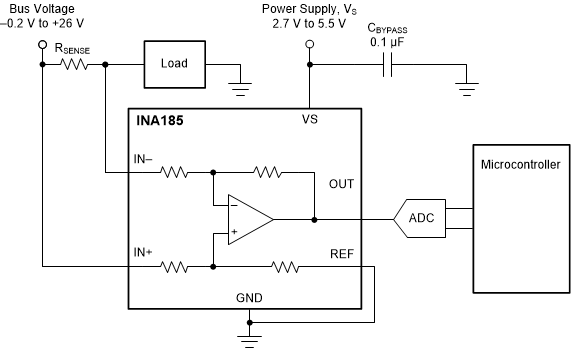SBOS378A March 2019 – November 2023 INA185
PRODUCTION DATA
- 1
- 1 Features
- 2 Applications
- 3 Description
- 4 Pin Configuration and Functions
- 5 Specifications
- 6 Detailed Description
- 7 Application and Implementation
- 8 Device and Documentation Support
- 9 Revision History
- 10Mechanical, Packaging, and Orderable Information
Package Options
Mechanical Data (Package|Pins)
Thermal pad, mechanical data (Package|Pins)
Orderable Information
7.1.1 Basic Connections
Figure 7-1 shows the basic connections of the INA185. Connect the input pins (IN+ and IN–) to the shunt resistor as close as possible to minimize any resistance in series with the shunt resistor.

NOTE: To help eliminate ground
offset errors between the device and the analog-to-digital converter (ADC),
connect the REF pin to the ADC reference input and then to ground. For best
performance, use an RC filter between the output of the INA185 and the ADC. See the Closed-Loop Analysis of Load-Induced Amplifier Stability
Issues Using ZOUT application note for more details.
Figure 7-1 Basic Connections for the INA185A power-supply bypass capacitor of at least 0.1 µF is required for proper operation. Applications with noisy or high-impedance power supplies can require additional decoupling capacitors to reject power-supply noise. Connect bypass capacitors close to the device pins.